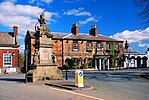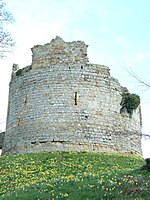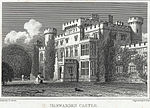Hawarden railway station
DfT Category F2 stationsFormer Great Central Railway stationsPages with no open date in Infobox stationRailway stations in FlintshireRailway stations in Great Britain opened in 1890 ... and 2 more
Railway stations served by Transport for Wales RailUse British English from November 2017

Hawarden railway station (Welsh: Penarlâg) serves the village of Hawarden in Flintshire, Wales. It is situated on the Borderlands Line 10½ miles (17 km) north of Wrexham Central and all passenger services are operated by Transport for Wales. The station is unstaffed.
Excerpt from the Wikipedia article Hawarden railway station (License: CC BY-SA 3.0, Authors, Images).Hawarden railway station
Woodlands Court,
Geographical coordinates (GPS) Address Nearby Places Show on map
Geographical coordinates (GPS)
| Latitude | Longitude |
|---|---|
| N 53.185 ° | E -3.032 ° |
Address
Hawarden
Woodlands Court
CH5 3NB , Hawarden
Wales, United Kingdom
Open on Google Maps









